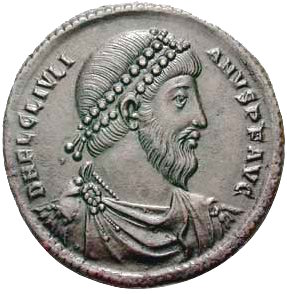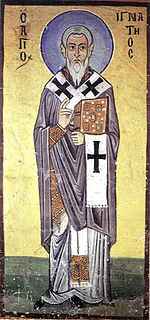
Ignatius of Antioch, also known as Ignatius Theophorus or Ignatius Nurono, was an early Christian writer and bishop of Antioch. En route to Rome, where he met his martyrdom, Ignatius wrote a series of letters. This correspondence now forms a central part of the later collection known as the Apostolic Fathers, of which he is considered one of the three chief ones together with Pope Clement I and Polycarp. His letters also serve as an example of early Christian theology. Important topics they address include ecclesiology, the sacraments, and the role of bishops.

Pope Julius I was Pope of the Catholic Church from 6 February 337 to his death in 352. He was notable for asserting the authority of the pope over the Arian Eastern bishops.

Antioch on the Orontes was an ancient Greek city on the eastern side of the Orontes River. Its ruins lie near the modern city of Antakya, Turkey, and lends the modern city its name.

Year 327 (CCCXXVII) was a common year starting on Sunday of the Julian calendar. At the time, it was known as the Year of the Consulship of Constantius and Maximus. The denomination 327 for this year has been used since the early medieval period, when the Anno Domini calendar era became the prevalent method in Europe for naming years.
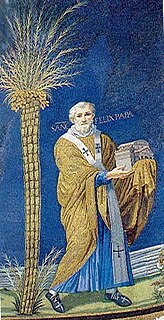
Pope Felix III was Pope from 13 March 483 to his death in 492. His repudiation of the Henotikon is considered the beginning of the Acacian schism. He is commemorated on March 1.

Saint Onesimus, also called Onesimus of Byzantium and The Holy Apostle Onesimus in some Eastern Orthodox churches, was probably a slave to Philemon of Colossae, a man of Christian faith. He may also be the same Onesimus named by Ignatius of Antioch as bishop in Ephesus which would put Onesimus's death closer to 95 A.D. Regardless, Onesimus went from slave to brother to Bishop.
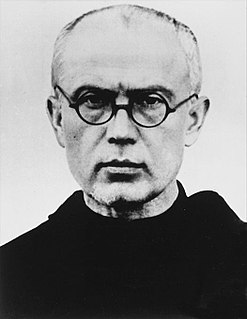
Maximilian Maria Kolbe, a Polish Conventual Franciscan friar, volunteered to die in place of a stranger in the German death camp of Auschwitz, located in German-occupied Poland during World War II. He had been active in promoting the veneration of the Immaculate Virgin Mary, founding and supervising the monastery of Niepokalanów near Warsaw, operating an amateur-radio station (SP3RN), and founding or running several other organizations and publications.

Maximilian I was the only monarch of the Second Mexican Empire. He was a younger brother of the Austrian emperor Franz Joseph I. After a distinguished career in the Austrian Navy as its commander, he accepted an offer by Napoleon III of France to rule Mexico, conditional on a national plebiscite in his favour. France, together with Spain and the United Kingdom, invaded the Mexican Republic in the winter of 1861, ostensibly to collect debts; the Spanish and British both withdrew the following year after negotiating agreements with Mexico's republican government, while France sought to conquer the country. Seeking to legitimize French rule, Napoleon III invited Maximilian to establish a new pro-French Mexican monarchy. With the support of the French army and a group of conservative Mexican monarchists hostile to the liberal administration of the new Mexican president, Benito Juárez, Maximilian was offered the position of Emperor of Mexico, which he accepted on 10 April 1864.

Margaret, known as Margaret of Antioch in the West, and as Saint Marina the Great Martyr in the East, is celebrated as a saint on July 20 in the Western Rite Orthodox, Roman Catholic and Anglican Churches, on July 17 by the Eastern-Rite Orthodox Church and on Epip 23 and Hathor 23 in the Coptic Churches.

John Maron, was a Syriac monk, and the first Maronite Patriarch. He is revered as a saint by the Maronite and Roman Catholic Churches, and is commemorated on March 2. He died and was buried in Kfarhy near Batroun, in Lebanon, where a shrine is dedicated to him.

The Syriac Orthodox Church of Antioch, or Syriac Orthodox Patriarchate of Antioch and All the East, is an Oriental Orthodox Church with autocephalous patriarchate established by Severus of Antioch in Antioch in 518, tracing its founding to Antioch by Saint Peter and Saint Paul in the 1st century, according to its tradition. The Church uses the Divine Liturgy of Saint James, associated with St. James, the "brother" of Jesus and patriarch among the Jewish Christians at Jerusalem. Syriac is the official and liturgical language of the Church based on Syriac Christianity. The primate of the church is the Syriac Orthodox Patriarch of Antioch currently Ignatius Aphrem II since 2014, seated in Cathedral of Saint George, Bab Tuma, Damascus, Syria.

The Syriac Catholic Church, also known as Syriac Catholic Patriarchate of Antioch, is an Eastern Catholic Christian Church in the Levant that uses the West Syriac Rite liturgy and has many practices and rites in common with the Syriac Orthodox Church. Being one of the twenty-three Eastern Catholic Churches, the Syriac Catholic Church has full autonomy and is a self-governed sui iuris Church while it is in full communion with the Holy See of Rome. The Syriac Catholic Church traces its history to the earliest days of Christianity. After the Calcedonian Schism the Church of Antioch became part of Oriental Orthodoxy, and was known as the Syriac Orthodox Church, while a new Antiochian Patriarchate was established to fill its place by the churches which accepted the Council of Calcedon. The Syriac Orthodox Church came into full communion with the Holy See and the modern Syriac Orthodox Church is a result of those that did not want to join the Catholic Church. Therefore the Syriac Catholic Church is the continuation of the original Church of Antioch.

Saint Meletius of Antioch (Μελέτιος) was a Christian bishop, or Patriarch of Antioch, from 360 until his death. There were contrasting views about his theological position: on the one hand, he was exiled three times under Arian emperors; on the other, he was strongly opposed by those faithful to the memory of the staunchly pro-Nicene Eustathius of Antioch, whom the synod of Melitene deposed for his Homousianism, which they considered a heresy, and by Saint Athanasius of Alexandria, the firm opponent of Arianism. One of his last acts was to preside over the First Council of Constantinople in 381.
Patriarch of Antioch is a traditional title held by the Bishop of Antioch As the traditional "overseer" of the first gentile Christian community, the position has been of prime importance in the church from its earliest period. This diocese is one of the few for which the names of its bishops from the apostolic beginnings have been preserved. Today five churches use the title of Patriarch of Antioch: the Syriac Orthodox Church, the Greek Orthodox Church of Antioch, the Syriac Catholic Church, the Melkite Greek Catholic Church, and the Maronite Church. Historically, there has also been a Latin Patriarch of Antioch.

Saint Severus the Great of Antioch, also known as Severus of Gaza, was the Patriarch of Antioch, and head of the Syriac Orthodox Church, from 512 until his death in 538. He is venerated as a saint in the Oriental Orthodox Church, and his feast day is 8 February.
Maximilian, Maximillian or Maximiliaan is a male given name. It was coined by Friedrich III for his son in 1459, explaining it as a combination of the names of two Roman generals, Maximus and Scipio Aemilianus. There was, however, an antecedent in Maximilianus, and several other prominent early Christians.

Ignatius Basile Moses I Daoud was Patriarch Emeritus of Antioch for the Syrian Catholic Church, a Cardinal Bishop, and Prefect Emeritus of the Congregation for the Oriental Churches in the Catholic Church.
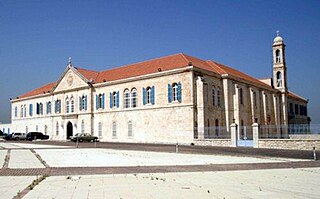
The Maronite Church is an Eastern Catholic sui iuris particular church in full communion with the Pope and the worldwide Catholic Church, with self-governance under the Code of Canons of the Eastern Churches. It is headed by Patriarch Bechara Boutros al-Rahi since 2011. Officially known as the Syriac Maronite Church of Antioch, it is part of Syriac Christianity by liturgy and heritage.
Saint Evodius or Euodias was an Early Christian bishop of Antioch, succeeding Saint Peter. He is regarded as one of the first identifiable Christians, and venerated as a saint.

Bara or al-Bara is one of the former "Dead Cities" in northwestern Syria. It is located in the Zawiya Mountain approximately 65 kilometres (40 mi) north from Hama and approx. 80 km southwest from Aleppo. Al-Bara is also town in Ariha district. According to the Syria Central Bureau of Statistics (CBS), al-Bara had a population of 10,353 in the 2004 census.

